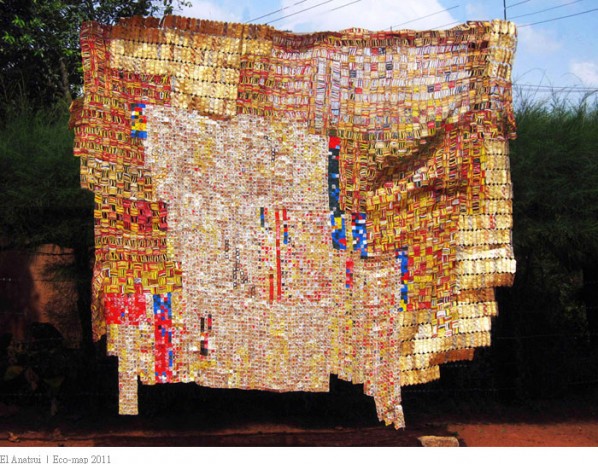El Anastsui’s newest work subtitled Eco-map which belongs to the Cloth Series is presented by Sakshi Gallery at Art Taipei 2011 at B18, which also represents his reflections on contemporary environment. He has used metals—aluminum strips from liqueur bottle caps, rusty metal graters used to make garri out of cassava, old offset printing plates, and evaporated milk cans—to create large-scale, wall-bound and freestanding “metal cloths” with immense visual power.

El Anastsui
As one of the most acclaimed sculptors on the international scene, El Anatsui is active for much of his career in Nigeria. Trained as a sculptor at the College of Art, Kwame Nkrumah University of Science and Technology, Kumasi, Ghana (1965- 68), El Anatsui has been a professor of sculpture at the University of Nigeria Nsukka where he became a leading member of the Nsukka School.

Sasa, 2004; Installation. Aluminum, copper wire; 640X840cm

Embrace by El Anatsui

El Anatsui, Dusasa II at the Venice Biennial 2007
Anatsui's preferred media are clay and wood, which he uses to create objects based on traditional Ghanaian beliefs and other subjects. He has cut wood with chainsaws and blackened it with acetylene torches; more recently, he has turned to installation art. Some of his works resemble woven cloths such as kente cloth. Anatsui also incorporates uli and nsibidi into his works alongside Ghanaian motifs. El Anatsui has his work exhibited around the world, including at the Metropolitan Museum of Art, New York (2008–09); National Museum of African Art, Washington, D.C. (2008); Venice Biennale (2007); Hayward Gallery (2005); Liverpool Biennial (2002); the National Museum of African Art (2001); the Centre de Cultura Contemporània de Barcelona (2001); the 8th Osaka Sculpture Triennale (1995); and the Venice Biennale (1990).





























